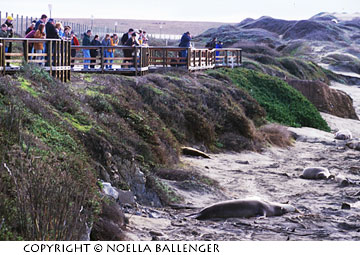
The Friends of the Elephant Seal have established a viewing area along the bluffs near San Simeon and Hearst Castle on the California coast. The activities at the Piedras Blancas rookery can be safely seen from the viewing walkway.
Last April during my Central California Coast workshop, I took our group to the Piedras Blancas Elephant Seal Rookery, about halfway between San Francisco and Los Angeles. Our goal was to photograph the elephant seals that have a breeding area, rookery, and sanctuary here. As we walked from the cars to the edge of the small bluffs, we could see seals almost covering the beach. What a sight!
There were patterns, textures, and colors to be photographed when we watched the young “weaners” as they molted. However, to be honest, observing them was as interesting as watching paint dry. Their activity was limited to a few sniffing/sneezes and an occasional yell when someone went over the top of the group to squeeze more comfortably into the crowd somewhere else. The docents who were at the overview (Friends of Elephant Seals) told us that the best time to observe excitement was during the months of late November, December, and January. So, just after Christmas this year, I met some friends to see what might be worth seeing.
Sex and Violence, Seal-Style
Through the end of November into January, the big bulls and pregnant females arrive. Fights break out over both territory and females. Babies are born, and the bulls that have triumphed in the battles mate with the females to ensure the next year’s batch of babies. The activity we observed on the beach was dramatic—especially since there was so much happening simultaneously. The noise was tremendous as bulls vocalized challenges while females called to their offspring and fended off unwanted challenges to mate or interruptions of their “motherly” chores. The noises resembled anything from chickens squawking or birds clamoring to (when the big bulls joined in) clanging like someone was banging on an empty pipe in the basement.
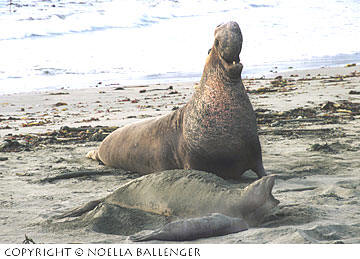
There is a great difference between the sizes of the male, the female, and the baby elephant seal. Here, the male is showing himself to a challenger. An alpha bull usually deters an interloper by chasing him briefly, vocalizing, or merely by rising far enough to let his opponent appreciate the size disadvantage.
As a nature photographer, I have a great curiosity about the life and habits of my subjects. The northern elephant seal is a very large mammal, even larger than the walrus. Mature bulls can be sixteen to eighteen feet long and weigh from four thousand to six thousand pounds! The more petite females measure about nine to twelve feet long and usually weigh between twelve hundred to two thousand pounds. As the males mature sexually, they develop a large, overhanging, proboscis-like snout. Their habitat tends to be coastal waters and sandy beaches. They feed on small sharks, rays, and squid. They like to feed in deep water–about six hundred fifty feet deep. In fact, they’re capable of diving to depths as great as five thousand feet to find food, although they usually feed at an average of four hundred fifty feet. They’re capable of remaining submerged for periods that average twenty minutes but can range up to eighty minutes. While they’re onshore to mate and birth babies, both male and females fast and can lose up to one-third of their body weight.
For years, the elephant seal was hunted almost to extinction. Now, thanks to the Federal Marine Protection Act of 1972, they’ve made a wonderful comeback. It’s estimated that between one hundred twenty thousand and one hundred fifty thousand elephant seals are now in existence, and the herd is expanding. In addition to man, the elephant seal’s primary enemy is the great white shark. Sharks attack their prey from below where the elephant seal is the most vulnerable.
As photographers, we need to understand what we’re seeing so we can create effective and insightful images. Winter presents great opportunities to photograph babies crying for their mothers, mothers interacting with their pups, males challenging and fighting with one another, and the commotion of all of the activities happening at once.
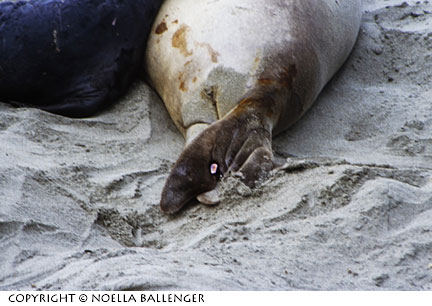
A white tag attached to the rear flipper of this elephant seal denotes that this seal was born at Piedras Blancas. Other rookeries use other colors. When tagging one of the “weaners,” the researchers wait until he goes into sleep apnea. Then they tag him and move out of the way as quickly as possible before the animal wakes up.
The first thing to understand is the life cycle of the animals and what happens at various times of the year. Pups are born in the period between December and March. They nurse for about twenty-seven days, gaining weight at an extremely rapid rate due to their mother’s rich milk. The mothers then abruptly stop nursing and begin to leave (they’ve been fasting during this entire period). When a mother begins the weaning process, she comes into estrus and mates. Gestation is about eleven months, and there is a delayed implantation period of up to three months. After the mothers leave, the pups are on their own. They fast and molt for about two months before departing for the sea.
When I first saw the pups in April, they were almost ready to venture out. As they teach themselves how to swim and find food, they’re vulnerable to high seas and storms that can wash them out to sea. Great white sharks prey on elephant seals of all ages. Once they leave the shore, the pups must dive deeply and stay near the bottom until they’re far enough away from land to move on safely.
The bulls return in summer to molt, and the juveniles in the fall. During the winter and summer there are northward migrations for the juveniles and females. The males migrate in both the spring and fall. However, the seals tend to return to their birth site for breeding, beginning the cycle again.
Tips for Capturing Great Photographs
I found the best time to photograph was early morning through noon. As the sun shifts to the west, the animals become silhouettes, and/or the contrast level during sunny moments adds different choices and challenges. But having said that, just being present is such an exceptional opportunity that photographing can be an all day excursion.
Lenses and Tripods
What equipment should you to take? The lens I chose as my primary was my 100-300 zoom. I knew that I’d be photographing some animals almost at my feet (about 10-12 feet away) as well as in the distance. I had a 1.4x and a 2x tele-converter available for use, as well, thus boosting my 300 mm lens to a 450mm or 600mm lens. I did keep a 28-80mm lens in my pocket, but I found that I preferred using the 100-300. A tripod is a must, because camera gear is just too heavy to hold for any length of time and you may be buffeted by winds coming on shore. If it is windy, stay low to the ground or add weight to your tripod for additional stability. Since any photo gear that is dropped over the bluffs (one of our group almost lost a camera) becomes too difficult and dangerous to retrieve, I suggest taking only what you absolutely need and using a camera vest or simple camera bag rather than a backpack or several bags. You’re close enough to your vehicle to make gear changes easily. Also, during the peak times of interest, there will be many tourists on the bluffs or along the viewing walkway. Leaving gear lying about can be dangerous for them and disastrous for you.
Choices of Film Speed
How do you photograph these phenomenal creatures? My film speed choice in April was 100 ISO. Remember, the seals were pretty still at that time as they lay there warming themselves in the sun. And the light was bright enough to make 100 speed film a good choice. The winter, however, was a different story with its abundance of action. The sky was primarily overcast and gray, although when the sun broke through the clouds, the sky became dazzling. Because I needed to stop the action and fight for light, I chose to move to a 400-speed film. Of course, when I put a tele-converter on, I lost one or two stops of light.
To Filter or Not
In April, I used a warming filter to bring out the rich tones of the animals’ skins. I used no filter in December, although I might reconsider that choice next time. Everything was so gray that an 81A or B warming filter might have enriched the quality of the images.
Anticipating the Shots
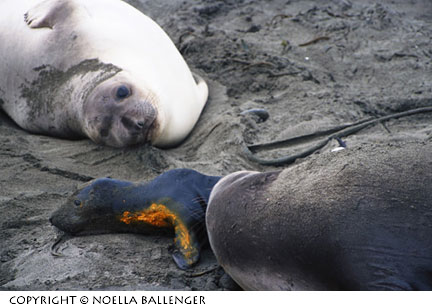
I was fortunate to see this baby born very close to where I was observing. This shot was taken just moments after he made his debut.
What kinds of shots can we expect to get? In April, I was intrigued by the textures, patterns, and colors on the sealskin. I thought their faces were sweet, and I wanted portraits. I noticed some of the elephant seals playing in the surf, but they were far from where I was located. Even with the long lens I was using, it was a stretch. In December, I looked for the behavior of the animals, their interaction with the pups and with one another. I tended to focus on one group for long periods of time. I wanted to see who was challenging or fighting, the mother with her pup, interactions between the pups (they were all too young and new for this), the way the mother and pup communicated, and how she protected her baby.
For those of us who enjoy animals, the Piedras Blancas Elephant Seal Rookery is a must- see. You’re able to approach the animals without interfering with their activities or placing yourself at risk. Although these animals tend to ignore people, they are big enough, strong enough, and determined enough not to look kindly on anyone who comes too close or interferes with their lives. Trust me, you’ll be happy keep your distance when you see and hear two large bulls begin to fight. Plan at least a half-day to enjoy this awesome sight.
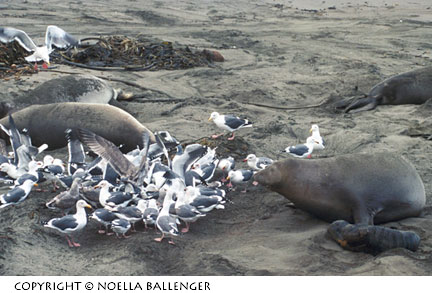
The mother delivered the afterbirth, and about fifty gulls swooped in. The gulls do a masterful job of keeping the beach clean. In February, when there are many more fatalities among the babies, turkey vultures assist in the clean-up efforts. It is nature’s way, but–according to the docent–February may not be the best month for people to visit who aren’t comfortable watching this activity.
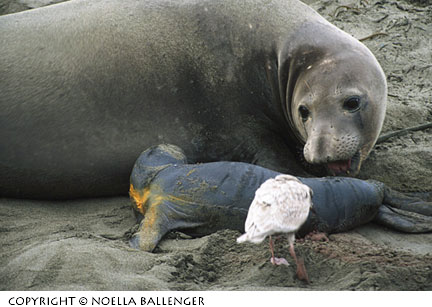
The mother circles her newborn baby, vocalizing so the two recognize one another by voice and bond. The umbilical cord is still attached to the baby and is being pecked by gulls.
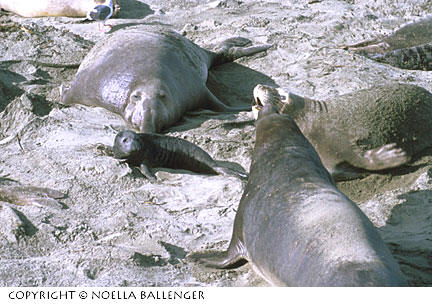
Wandering between two challenging males can place babies in mortal danger. The mothers are quite aggressive and vocal in defending their babies, but the babies are frequently killed. One of the most hazardous times for a baby is when the mother comes into estrus and the bulls become even more aggressive and relentless in their pursuit and mating practices.
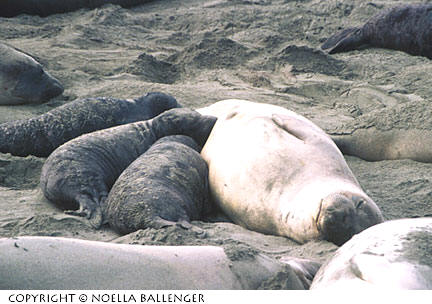
This is an example of poor mothering. In most cases, only one baby is born per season to a mother. She produces enough milk to support only her pup. If another pup sneaks in for a feeding, valuable nutrition is taken away from her pup and greatly increases the chance that it will be undernourished and not survive.
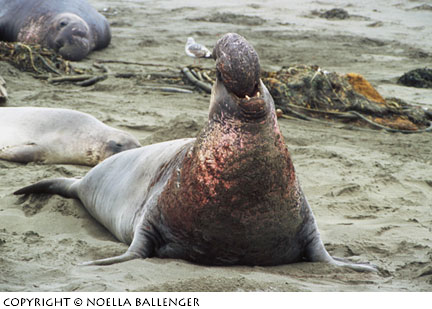
An alpha bull shows his breastplate. The breastplate is a thick layer of fat that protects the bull. Obviously, this male is a tremendous fighter, judging from the scars and wounds from many battles.
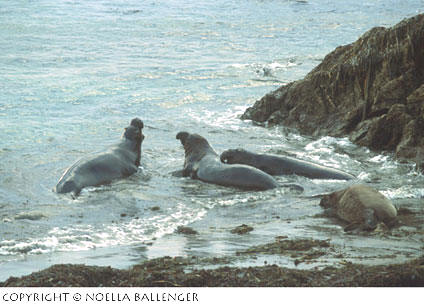
One of the main activities of the sub-adult males is vocalizing and fighting at the water’s edge. These are training sessions for the time when they will have to battle other males to mate.
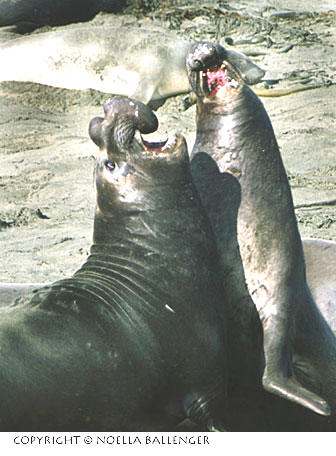
If a challenge is accepted and a fight begins, it can last for mere moments or until one of the combatants backs off or is killed. Two males fight by banging their chests together and trying to get into position to bite one another. There is much vocalizing as well as shoving and biting. Eventually, one will back down and retreat.
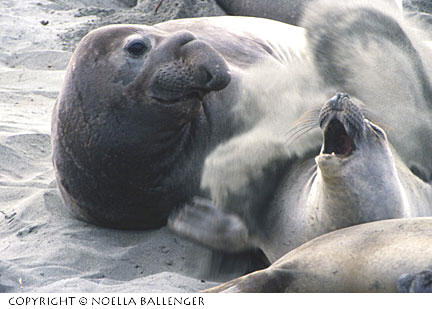
The mating behavior is interesting. During the initial approach of a male wanting to mate, the female does a lot of vocalizing. She will try to flee and, if that’s not possible, she thrashes about and throws sand.
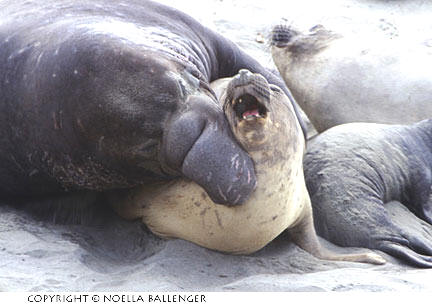
Mating can become very rough as the male bites hard enough to hold the female in place.
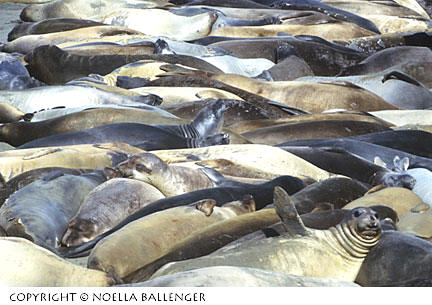
In April, we observed these “weaners” in the final stages of molting the shiny black coats in which they were born and preparing to depart. They were born in the previous December-March period. Their mothers moved on by early March, leaving them on their own. Babies are born weighing about sixty pounds. During the month when they nurse, they increase their weight to about three hundred fifty pounds. In March and April, after the mothers leave them, they fast.
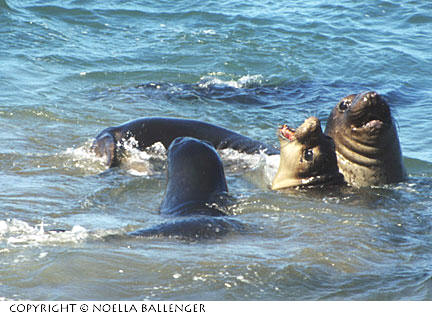
As hunger and curiosity begin to make them restless, the “weaners” will teach themselves how to swim and find food before they leave the shelter of the rookery.

Leave a Reply